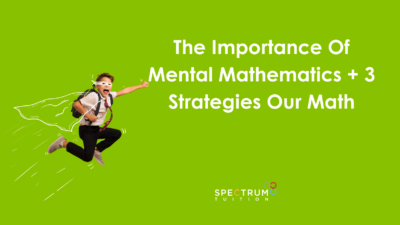In a world where most people walk around with a mobile phone in their pocket at all times, it is often suggested that we no longer need mental maths skills. Many people assume that the ability to add, subtract, multiply and divide numbers quickly in our head is useless in a day and age when a phone, calculator or computer can do it better. So why do we still teach students mental arithmetic? And, more importantly, is this still a skill worth teaching?
To put it simply, yes! While calculators are a wonderful invention, there are many benefits of having good mental maths skills. So here are the 3 most important reasons for your child to improve their mental maths skills. We’ll also give the top 3 tips that our maths tutors use every day!
1. Mental maths provides a deeper understanding of calculation
Imagine you wanted to order 4 sandwiches each for 14 people. You grab your calculator and type in 4 x 14. However, as you are typing, your finger slips and you accidentally type 4 x 144. The calculator gives you the answer 576. If you have good mental maths skills, you would probably notice something a bit odd. Based on your own understanding of how multiplication works, you would reason that 576 was far too many sandwiches.
As such, you could type the equation in to your calculator again and get the correct answer, which is 56. However, if you ignore mental maths and always trust the calculator, your little slip of the finger can be disastrous! Imagine accidentally buying 576 sandwiches when you only needed 56! This point is especially relevant for VCE students who, if they rely too heavily on their calculators during their exams, can lose valuable marks.
Watch the following video of how a Spectrum Tuition student (and my daughter) demonstrates a mental maths technique that our maths tutors use in our classes:
2. Mental maths is vital in exams without calculators
Like it or not, our current school system requires students to complete a majority of their exams without calculators. We adults can always pull out our phones to check our working out. However, students are required to rely on their own abilities to add, subtract, multiply and divide numbers. And while all students are taught techniques to work out sums on paper, the ability to quickly do sums in their heads can help students save valuable seconds and even minutes in an exam situation.
During multiple choice exams, mental maths can make life a lot easier. It provides a quick way of narrowing down which answers might be correct. can also help to figure out which are definitely wrong, making it much easier to choose the correct answer.
When preparing our students for Selective School and Scholarship exams, our maths tutors give techniques to answer questions as quickly and as accurately as possible. The ability to quickly perform calculations in their head is one of the most valuable tools that students can have from primary all the way to VCE.
3. Mental maths is practical in real life
The ability to quickly calculate complicated sums is also a valuable life skill. Whether you’re trying to figure out how much your shopping cart is, how to split the bill at a dinner party or trying to work out how many boxes you will need to pack all of your groceries, or trying to figure out much money you have left over after making a purchase, mental maths will make your life easier.
By developing good mental maths skills from a young age, children are able to improve other skillsets and easily work out answers to mathematical scenarios in everyday life. It’s never too early or too late to start giving your child the foundational skills that they will need to succeed throughout their mathematics education.
Tips from Our Maths Tutors
Below are three further strategies to try out today.
a. Adding from left to right
25 + 36
Similar to the above strategy, this technique requires that you break both numbers into tens and ones
20 + 30 + 5 + 6
= 50 + 11
= 61
b. Compensation strategy
34 + 49
First, since 49 is so close to 50, we will add 1 to 49 which will make it easier to solve:
34 + 50
= 84
Then, since we added one extra to the original equation, we have to subtract one from the final answer
= 83
c. Using friendly numbers
Friendly numbers are numbers that are easy to work with. For example, multiples of 10 are “friendly” because they are easy to work with when we add or subtract.
We begin by getting to a friendly number, which is typically a multiple of 10, 100, or 100 – depending on the numbers that we are working with. Then we add on the remainder.
265 + 18
We can add 5 from the 18 to get to a friendly number 270.
We have 13 left. so now we can simply add the 13 to the 270 to get a final answer of 283.
Mental maths is not about following a one size fits all process. It involves having many “tools” available and being able to effectively choose and use a tool to solve an equation. The important thing to remember is that we don’t want to force our students into using a tool that doesn’t work for them. This is why it’s so important to introduce a variety of different strategies, teach them in isolation to allow mastery, and then allow students to begin choosing the tool that works best for them individually.
Going back to our original problem at the start of this email, now that we have a number of mental maths strategies, we can solve the problem as follows:
Most students are comfortable with their times tables up to 12. Therefore, to solve 14 x 4, we might break up the sum as follows:
12 x 4 = 48
2 x 4 = 8
We then add the answers using the ‘friendly numbers’ strategy.
48 + 8 = 56
If you want to learn more about how our tutors can help your child develop their mathematics and English skills, click here to download a free course booklet catered to your child’s needs.


